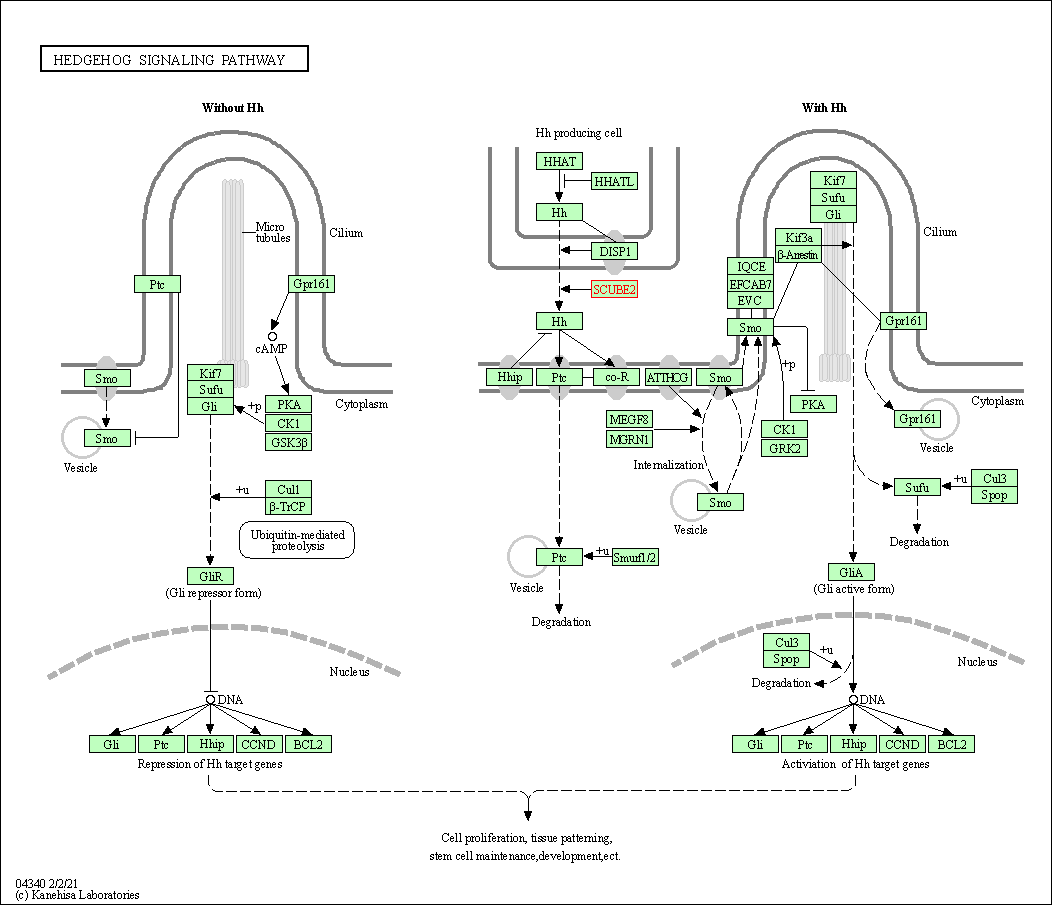Target Information
| Target General Information | Top | |||||
|---|---|---|---|---|---|---|
| Target ID |
T27170
(Former ID: TTDI00119)
|
|||||
| Target Name |
Signal peptide CUB-EGF-like-domain containing 2 (SCUBE2)
|
|||||
| Synonyms |
Signal peptide, CUB and EGF-like domain-containing protein 2; Scube/You; Protein CEGP1; CEGP1
Click to Show/Hide
|
|||||
| Gene Name |
SCUBE2
|
|||||
| Target Type |
Literature-reported target
|
[1] | ||||
| Function |
Lipid-binding protein required for SHH long-range signaling by binding to the dually lipid-modified SHH (ShhNp) and by promoting ShhNp mobilization, solubilization and release from the cell membrane. Acts by enhancing the proteolytic processing (shedding) of the lipid-modified N- and C- terminal of ShhNp at the cell surface. Synergizes with DISP1 to increase SHH secretion. Probable cell surface coreceptor for VEGFR2 involved in VEGFR2-mediated angiogenesis.
Click to Show/Hide
|
|||||
| UniProt ID | ||||||
| Sequence |
MGVAGRNRPGAAWAVLLLLLLLPPLLLLAGAVPPGRGRAAGPQEDVDECAQGLDDCHADA
LCQNTPTSYKCSCKPGYQGEGRQCEDIDECGNELNGGCVHDCLNIPGNYRCTCFDGFMLA HDGHNCLDVDECLENNGGCQHTCVNVMGSYECCCKEGFFLSDNQHTCIHRSEEGLSCMNK DHGCSHICKEAPRGSVACECRPGFELAKNQRDCILTCNHGNGGCQHSCDDTADGPECSCH PQYKMHTDGRSCLEREDTVLEVTESNTTSVVDGDKRVKRRLLMETCAVNNGGCDRTCKDT STGVHCSCPVGFTLQLDGKTCKDIDECQTRNGGCDHFCKNIVGSFDCGCKKGFKLLTDEK SCQDVDECSLDRTCDHSCINHPGTFACACNRGYTLYGFTHCGDTNECSINNGGCQQVCVN TVGSYECQCHPGYKLHWNKKDCVEVKGLLPTSVSPRVSLHCGKSGGGDGCFLRCHSGIHL SSDVTTIRTSVTFKLNEGKCSLKNAELFPEGLRPALPEKHSSVKESFRYVNLTCSSGKQV PGAPGRPSTPKEMFITVEFELETNQKEVTASCDLSCIVKRTEKRLRKAIRTLRKAVHREQ FHLQLSGMNLDVAKKPPRTSERQAESCGVGQGHAENQCVSCRAGTYYDGARERCILCPNG TFQNEEGQMTCEPCPRPGNSGALKTPEAWNMSECGGLCQPGEYSADGFAPCQLCALGTFQ PEAGRTSCFPCGGGLATKHQGATSFQDCETRVQCSPGHFYNTTTHRCIRCPVGTYQPEFG KNNCVSCPGNTTTDFDGSTNITQCKNRRCGGELGDFTGYIESPNYPGNYPANTECTWTIN PPPKRRILIVVPEIFLPIEDDCGDYLVMRKTSSSNSVTTYETCQTYERPIAFTSRSKKLW IQFKSNEGNSARGFQVPYVTYDEDYQELIEDIVRDGRLYASENHQEILKDKKLIKALFDV LAHPQNYFKYTAQESREMFPRSFIRLLRSKVSRFLRPYK Click to Show/Hide
|
|||||
| 3D Structure | Click to Show 3D Structure of This Target | AlphaFold | ||||
| Cell-based Target Expression Variations | Top | |||||
|---|---|---|---|---|---|---|
| Cell-based Target Expression Variations | ||||||
| Different Human System Profiles of Target | Top |
|---|---|
|
Human Similarity Proteins
of target is determined by comparing the sequence similarity of all human proteins with the target based on BLAST. The similarity proteins for a target are defined as the proteins with E-value < 0.005 and outside the protein families of the target.
A target that has fewer human similarity proteins outside its family is commonly regarded to possess a greater capacity to avoid undesired interactions and thus increase the possibility of finding successful drugs
(Brief Bioinform, 21: 649-662, 2020).
Human Pathway Affiliation
of target is determined by the life-essential pathways provided on KEGG database. The target-affiliated pathways were defined based on the following two criteria (a) the pathways of the studied target should be life-essential for both healthy individuals and patients, and (b) the studied target should occupy an upstream position in the pathways and therefore had the ability to regulate biological function.
Targets involved in a fewer pathways have greater likelihood to be successfully developed, while those associated with more human pathways increase the chance of undesirable interferences with other human processes
(Pharmacol Rev, 58: 259-279, 2006).
Biological Network Descriptors
of target is determined based on a human protein-protein interactions (PPI) network consisting of 9,309 proteins and 52,713 PPIs, which were with a high confidence score of ≥ 0.95 collected from STRING database.
The network properties of targets based on protein-protein interactions (PPIs) have been widely adopted for the assessment of target’s druggability. Proteins with high node degree tend to have a high impact on network function through multiple interactions, while proteins with high betweenness centrality are regarded to be central for communication in interaction networks and regulate the flow of signaling information
(Front Pharmacol, 9, 1245, 2018;
Curr Opin Struct Biol. 44:134-142, 2017).
Human Similarity Proteins
Human Pathway Affiliation
Biological Network Descriptors
|
|
| KEGG Pathway | Pathway ID | Affiliated Target | Pathway Map |
|---|---|---|---|
| Hedgehog signaling pathway | hsa04340 | Affiliated Target |

|
| Class: Environmental Information Processing => Signal transduction | Pathway Hierarchy | ||
| Degree | 1 | Degree centrality | 1.07E-04 | Betweenness centrality | 0.00E+00 |
|---|---|---|---|---|---|
| Closeness centrality | 1.67E-01 | Radiality | 1.26E+01 | Clustering coefficient | 0.00E+00 |
| Neighborhood connectivity | 1.50E+01 | Topological coefficient | 1.00E+00 | Eccentricity | 13 |
| Download | Click to Download the Full PPI Network of This Target | ||||
| References | Top | |||||
|---|---|---|---|---|---|---|
| REF 1 | Decreased expression of SCUBE2 is associated with progression and prognosis in colorectal cancer. Oncol Rep. 2015 Apr;33(4):1956-64. | |||||
If You Find Any Error in Data or Bug in Web Service, Please Kindly Report It to Dr. Zhou and Dr. Zhang.

